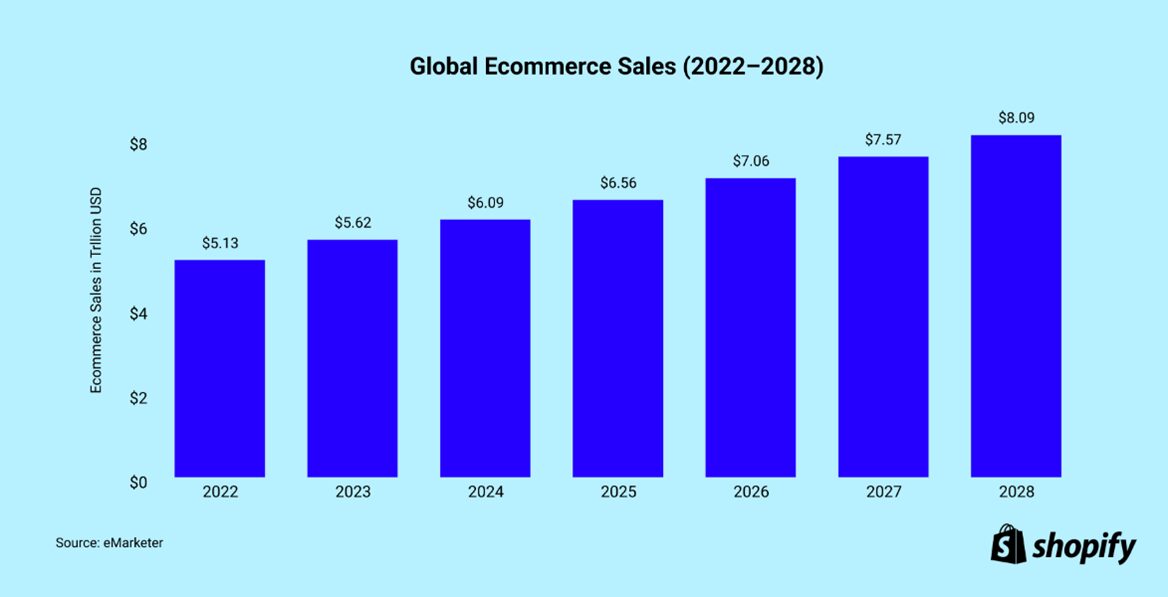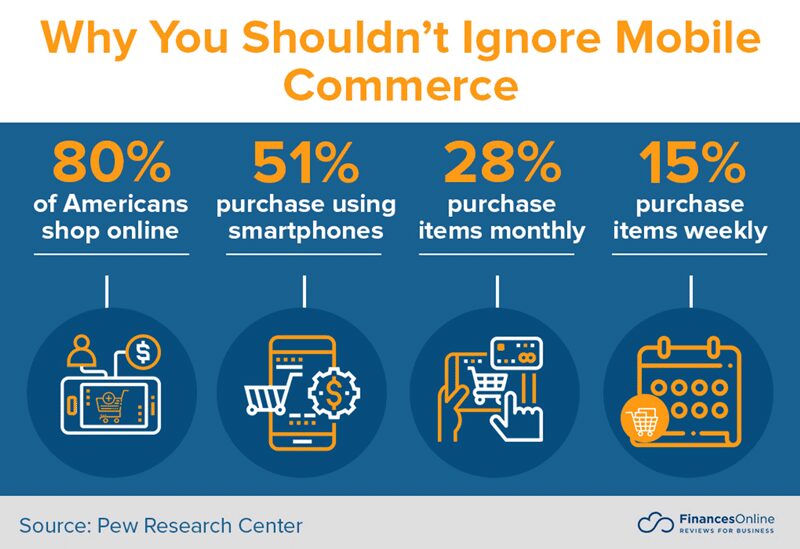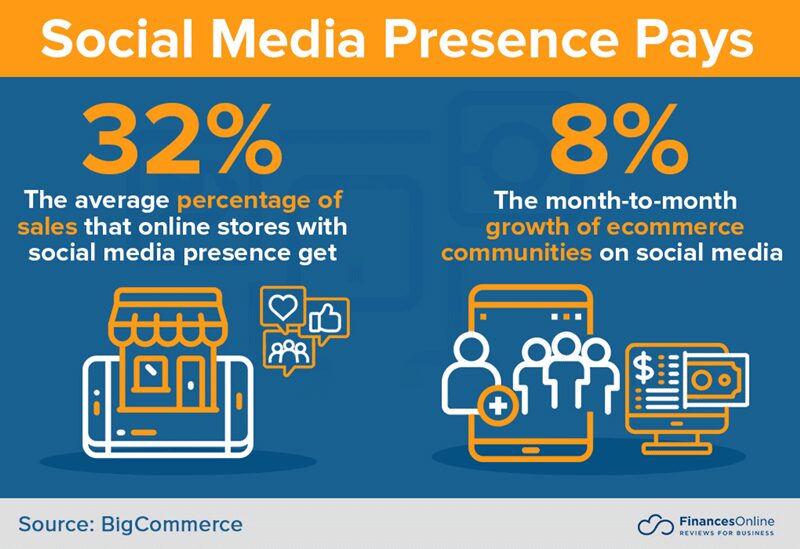A huge percentage of the workforce has chosen to work from home. Work can be accomplished from anywhere, even the beach or park bench.
With the popularity of online shopping, the prevalence of social media use, the implementation of 5G networks, and the increasingly sophisticated computers available on the market, having a commercial space is no longer a requirement for building a thriving company. You can easily facilitate transactions from the comfort of your own home or virtually anywhere in the world therefore, you can actually be on vacation and continue to work on building a home-based business.
Mobile Commerce
Modern business has an overarching tenet–get to customers wherever they are. This is part of the strong general trend of having a customer-centric focus regardless of the type of business that you may be developing. The smartphone enables us to find customers where they are wherever they are. Available data reveals that consumers spend a significant amount of time on their smartphones. People check their mobile phones about 96 times a day, which equates to at least once every 10 minutes thus, clever entrepreneurs leverage this to their advantage. This type of new activity paves the way for effective mobile commerce. Now, individual entrepreneurs can chip away at their giant competitors even from the comfort of their homes because technology is the enabler and the game changer.
Key Mobile Commerce Takeaways:
- As phones gain more powerful computational powers, many consumers are choosing to access online shops through their mobile devices. For those who are marketing a product or service that consumers purchase; it will be wise to include a streamlined mobile commerce process.
- With the growing market share of mobile commerce, we can expect more options for mobile payments and transactions in the near future.

Global Ecommerce Sales chart description
This bar chart displays the projected growth of global ecommerce sales from 2022 to 2028, measured in trillions of USD:
- 2022: $5.13 trillion
- 2023: $5.62 trillion
- 2024: $6.09 trillion
- 2025: $6.66 trillion
- 2026: $7.06 trillion
- 2027: $7.57 trillion
- 2028: $8.09 trillion
The data shows consistent year-over-year growth, with global ecommerce sales projected to increase by approximately 58% from 2022 to 2028, rising from $5.13 trillion to $8.09 trillion.
Source: eMarketer

Mobile Commerce infographic text description
Why You Shouldn’t Ignore Mobile Commerce
This infographic presents four key statistics about mobile commerce behavior:
- 80% of Americans shop online – Illustrated with an icon showing a person using a tablet/device with shopping cart and dollar sign
- 51% purchase using smartphones – Illustrated with a smartphone icon showing shopping cart and gear/settings symbol
- 28% purchase items monthly – Illustrated with a cursor clicking on a shopping interface with credit card
- 15% purchase items weekly – Illustrated with a calendar icon showing shopping cart symbol
The statistics demonstrate the significant role of mobile devices in online shopping, from general online shopping adoption to specific mobile purchasing frequency patterns.
Source: Pew Research Center
Created by: FinancesOnline
Social Commerce
Social commerce is a natural progression as eCommerce and social media both become widely used. Individual entrepreneurs using social platforms do not simply engage to become “social” they get good at selling/sharing and influencing others to buy. Taking the time to master a social platform is a new tool that enhances the business from home option. We anticipate that social selling will be even more sophisticated in the coming years with shiny new digital tools and sets of best practices for each platform.

Social Media infographic text description
Social Media Presence Pays
This infographic highlights two key statistics about the impact of social media on ecommerce:
- 32% – The average percentage of sales that online stores with social media presence get. Illustrated with an icon showing a laptop displaying an online storefront alongside social media engagement symbols (hearts, likes, and people icons).
- 8% – The month-to-month growth of ecommerce communities on social media. Illustrated with icons showing community growth (people figures with a plus sign) and ecommerce analytics (computer monitor with financial data).
These statistics demonstrate the significant financial benefits and growth potential of maintaining an active social media presence for online businesses.
Source: BigCommerce
Created by: FinancesOnline
Key Social Commerce Takeaways:
- Social commerce is where social media and ecommerce meet. The medium makes it easier to give and receive feedback. In some sense, it recreates an in-person marketplace digitally. Thus, it gives users an authentic feel by making it more personal. This is its greatest come on and this will concretize its standing among other ecommerce avenues in the years to come.
- In the coming years, social networks will provide their users with new tools for social selling. To wit, many marketers and other business experts will compile the best practices for social commerce. Entrepreneurs and aspiring entrepreneurs should watch out for these.
The Gig Economy
The gig economy in the United States is projected to be a significant part of the overall economy, with gig workers making up approximately 25% of the global workforce as of 2024. This includes freelancers, independent contractors, and other non-permanent workers who are hired on a per-project basis. The gig economy is expected to contribute over $1 trillion to the global economy in 2024.
The gig economy market is valued at USD 556.7 billion in 2024 and is forecasted to increase to USD 646.77 billion in 2025, surpassing USD 2146.87 billion by 2033, expanding at a CAGR of 16.18% from 2025 to 2033.
Key Gig Economy Takeaways:
- The global gig economy will continue to grow with more and more options and choices becoming available.
- There are many benefits to transitioning to or creating a gig-like scheme for any small business.
- Access to information, insurance products and financial services are available to all members of The Association For Entrepreneurship where membership is affordable ($4.99 per month). Membership is available to any type of independent worker/individual entrepreneur. AFEUSA.org
Citation: The information shared in this article was published on the digital platform of Finances Online. The article was written by Finances Online Resident B2B expert Astrid Eira. The original article can be reviewed at: 16 Entrepreneurship Trends for 2024: New Forecasts & A Look Into What’s Ahead – Financesonline.com

Article contributed by
Astrid Eira
Senior Writer,
FinancesOnline.com
